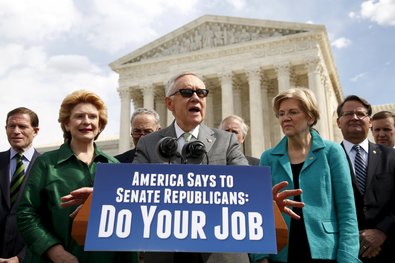
Could Term Limits Ease Fights Over Supreme Court Nominees?
The death of Justice Antonin Scalia has set off one of the most contentious battles ever over a Supreme Court seat. Republicans who control the Senate say they will not consider anyone who President Obama presents for their confirmation before the election, including his nominee, Judge Merrick B. Garland. Some say if the justices’ life tenure was ended , each confirmation fight would be less fraught and contentious. Should Supreme Court terms be limited?
* justice = 판사, 재판관/ term limit = 임기 제한/ ease = 덜어주다/ set off = (일련의 사건·과정을) 유발하다[일으키다]/ contentious = 논쟁을 초래할/ confirmation = 승인/ life tenure = 종신직/ fraught = 걱정스러운
 대법원 (판사) 임기는 제한 되어야 하나요?
대법원 (판사) 임기는 제한 되어야 하나요?
1. A Fixed Term Would Lower the Heat
An 18-year fixed term with regularized vacancies every two years would let each president appoint two justices per term.
2. Term Limits Would Create Their Own Problems
Term-limited justices might aspire to political office, or positions in business, and these aspirations might shape their judicial decisions.
Sample Essay
Supreme Court Term Limits Would Create Their Own Problems
Since Justice Scalia’s death, the role of justices’ life tenure in amplifying the politicization of the nomination process has been getting more consideration. When judicial seats are less likely to turn over, the importance of each appointment may seem especially acute. Term limits, which most state high courts use, would assure that Supreme Court vacancies would become available at a predictable pace, perhaps avoiding the politicking and gridlock that has accompanied the nomination process in recent years.
While all of this sounds appealing, there are other concerns to weigh. As an initial matter, replacing life tenure with term limits would likely require a constitutional amendment, by itself a daunting and difficult process.
Leaving aside the difficulties of the amendment process, there are ethical concerns that counsel against term limits. Term-limited justices might aspire to other political offices, or positions in business, and these post-term aspirations might shape their judicial decision-making on the court. For all its problems, life tenure was intended to insulate judges — and their decisions — from these pressures.
And while we might reasonably worry about the mental acuity of elderly justices, many justices hit their jurisprudential stride later in their careers. As Andrew Martin and Kevin Quinn argue, justices’ views do not remain fixed, but rather evolve over the course of their careers. This is hardly surprising. Developing a judicial philosophy and an interpretive approach can take time — perhaps longer than the 18 years that is typically floated as the optimal time frame for judicial term limits.
If, as Martin and Quinn argue, juridical drift is the rule, rather than the exception, the assurance of life tenure may mean that a justice will be able to take a longitudinal approach to her decisions, steadily evolving over time. In a term-limited environment, justices might feel immediate pressure to identify and enact a distinct interpretative approach, stymieing the deliberative and organic growth that lengthier tenures could afford.
Term-limited justices undoubtedly will recognize that their time on the court — and their time with a particular group of justices — is finite. This too may shape their decision-making. Eager to initiate a doctrinal shift or reverse a particular precedent, but worried about the changing composition of a term-limited Court, justices may be inclined to make lurching shifts from left to right and back again within a relatively short period of time. This kind of jurisprudential volatility is completely at odds with our precedent-based legal system and its vision of slow and steady doctrinal development.





![]() 대법원 (판사) 임기는 제한 되어야 하나요?
대법원 (판사) 임기는 제한 되어야 하나요?






